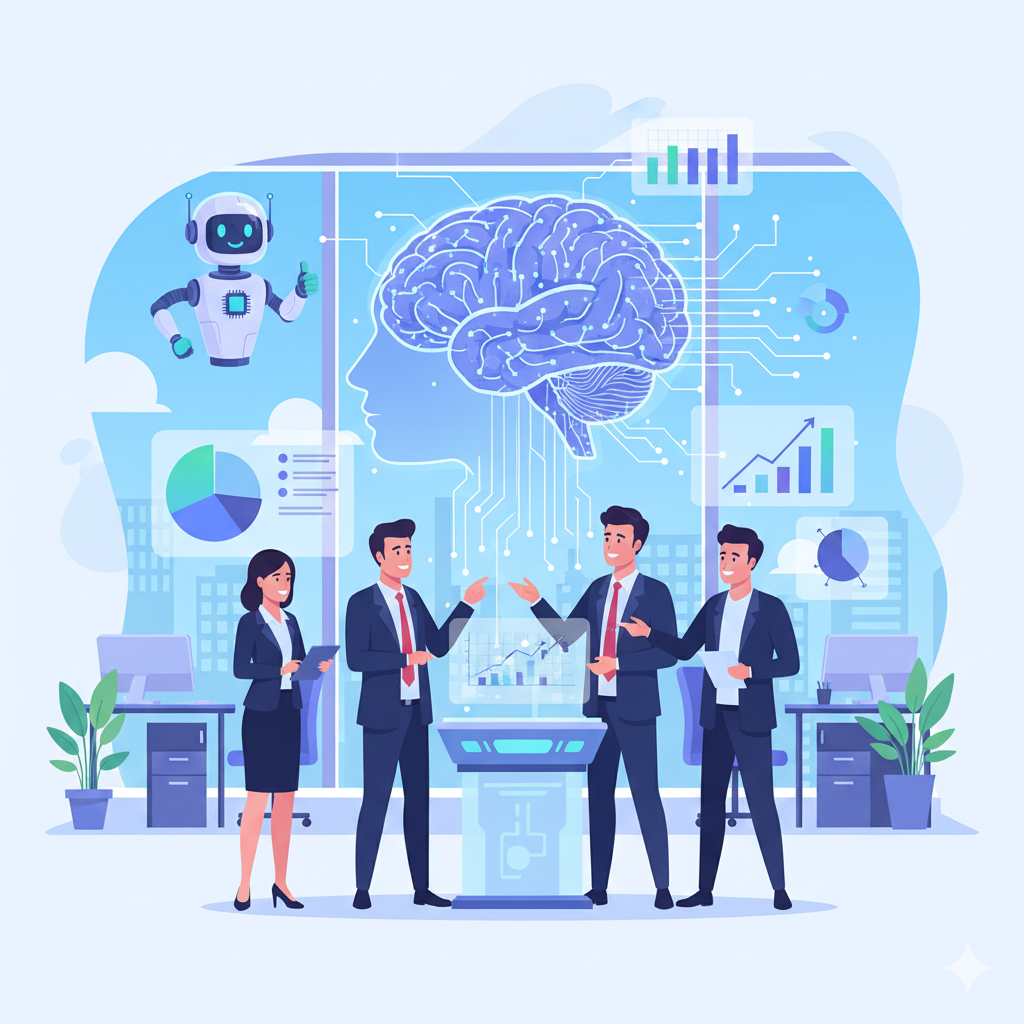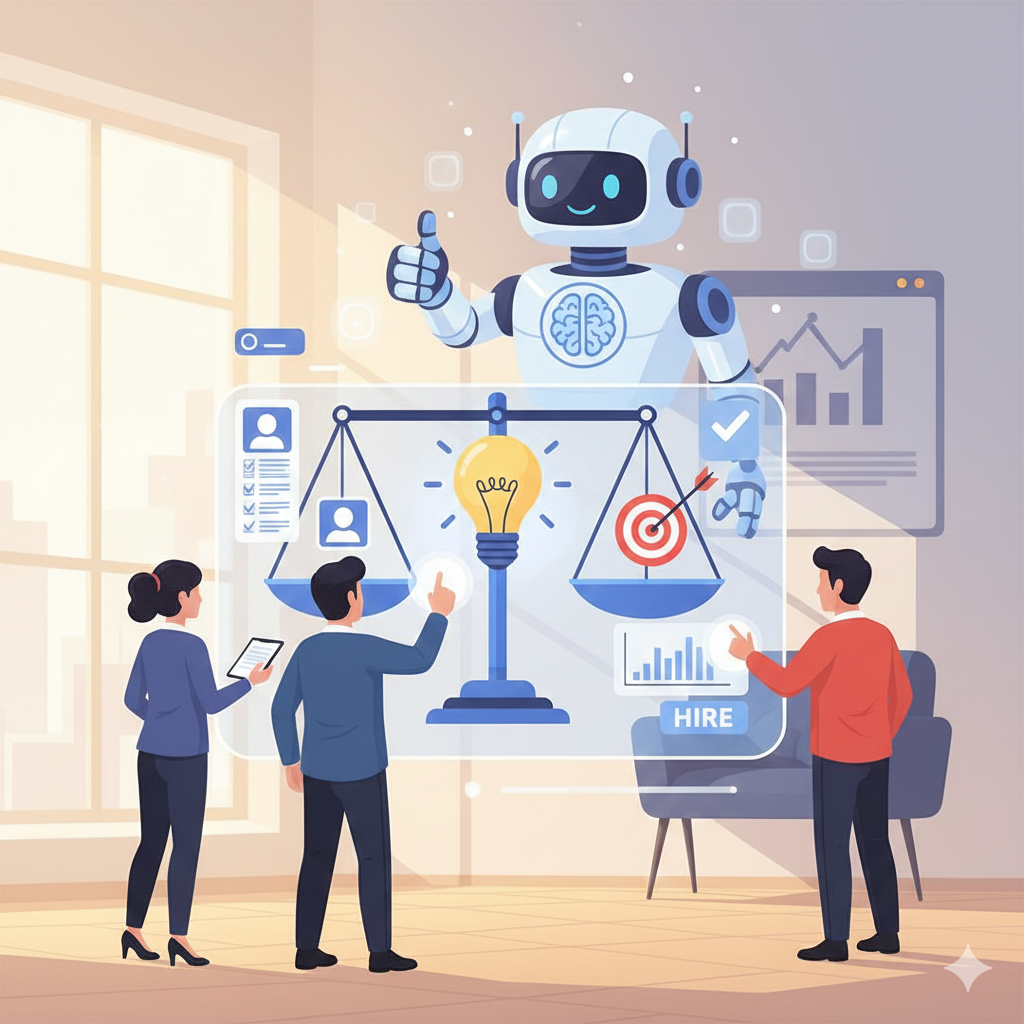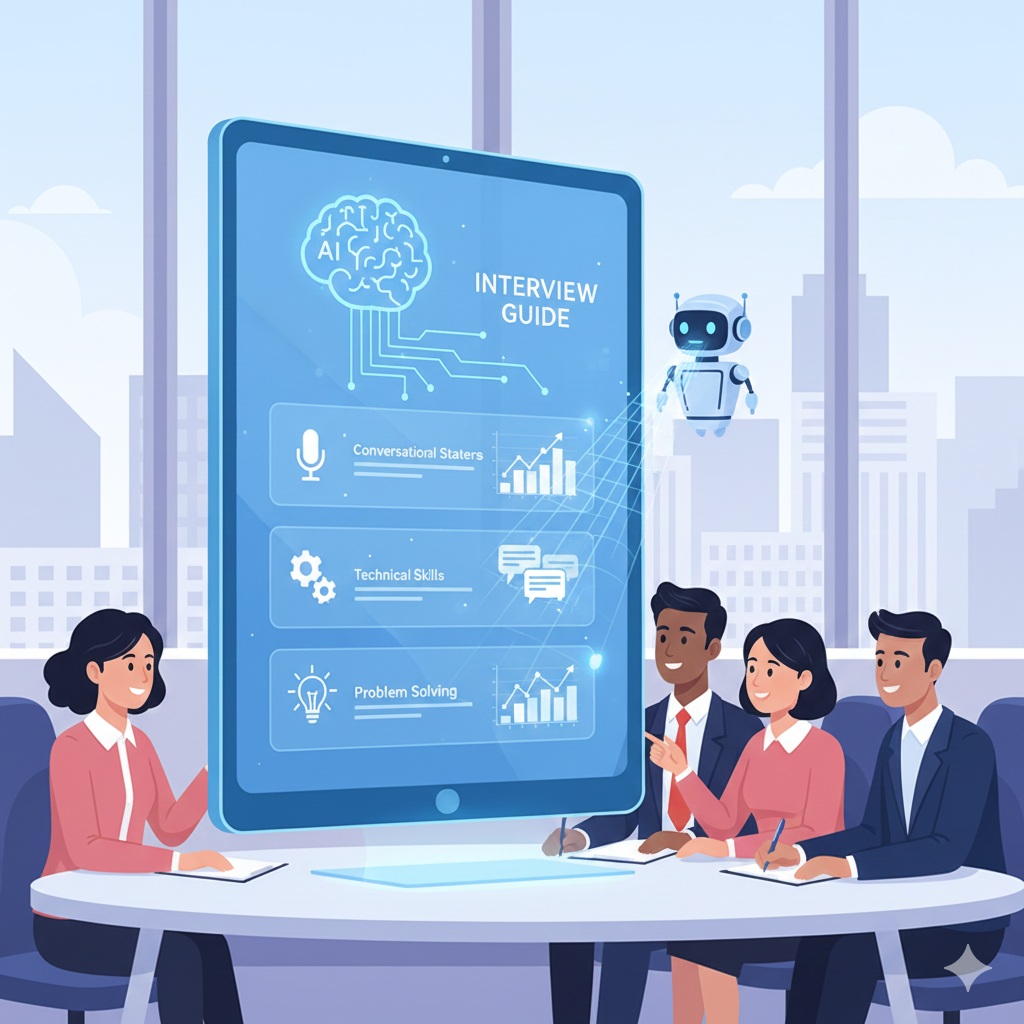

Agentic AI is transforming recruitment through autonomous decision-making systems that can screen, assess, and evaluate candidates independently. Unlike traditional automation tools that simply follow predefined rules, these sophisticated systems demonstrate genuine intelligence by learning from outcomes, adapting to new scenarios, and making complex judgments that previously required human intervention. As recruitment teams face mounting pressure to process higher candidate volumes while maintaining quality standards, agentic AI offers compelling solutions that go far beyond basic screening automation.
However, finding the right balance between automated efficiency and human oversight has become critical for organisations seeking to harness AI’s power while maintaining the nuanced judgment that effective recruitment requires. The challenge lies not in replacing human recruiters but in creating sophisticated partnerships where AI handles routine decisions while humans focus on relationship building, complex evaluations, and strategic hiring decisions. This balance ensures both operational efficiency and meaningful candidate engagement throughout the recruitment journey.
Agentic AI in recruitment balances automation with human oversight by creating autonomous decision-making systems that handle routine screening and assessment tasks while strategically incorporating human intervention at critical touchpoints. This sophisticated approach enables AI systems to process large candidate volumes efficiently while preserving human judgment for complex evaluations, relationship building, and nuanced decision-making that requires contextual understanding and emotional intelligence.
The key to successful implementation lies in defining clear autonomy boundaries where AI operates independently for straightforward decisions while escalating complex scenarios to human recruiters. This human-AI collaboration maximizes operational efficiency while preserving the personal elements that enhance candidate experience and hiring quality.
Agentic AI represents a significant evolution beyond traditional rule-based automation, featuring systems that can make autonomous decisions, learn from outcomes, and adapt their behaviour based on changing recruitment contexts. These advanced systems demonstrate what researchers call “goal-directed behaviour,” meaning they can pursue recruitment objectives through flexible strategies rather than rigid programming. Unlike basic screening tools that simply match keywords or filter applications based on predetermined criteria, agentic AI systems can evaluate complex scenarios, weigh multiple factors simultaneously, and make nuanced judgments about candidate suitability.
The distinction becomes clear when comparing traditional automation with agentic systems. While conventional recruitment tools might automatically reject candidates lacking specific qualifications, agentic AI can recognise when alternative experience or transferable skills might compensate for apparent gaps. These systems continuously analyse patterns across successful hires, identifying subtle indicators of potential that human reviewers might miss while processing hundreds of applications. This sophisticated decision-making capability enables organisations to maintain consistent evaluation standards while adapting to unique candidate profiles and evolving role requirements.
Modern platforms like impress.ai’s Recruitment Automation Platform exemplify this evolution, moving beyond simple filtering to provide intelligent candidate evaluation that considers multiple dimensions simultaneously. These systems can process complex data patterns, recognise exceptional candidates who might not fit traditional profiles, and make recommendations based on comprehensive analysis rather than surface-level criteria. This represents a fundamental shift in how recruitment technology supports talent acquisition, transforming from passive tools into active decision-making partners.
Modern agentic AI systems can independently evaluate candidate suitability across multiple dimensions, from technical skills assessment to cultural fit analysis. These systems process vast amounts of information simultaneously, considering factors such as work experience relevance, skill progression patterns, educational background context, and even communication style indicators derived from application materials. Unlike human reviewers who might unconsciously prioritise certain criteria, agentic AI maintains consistent evaluation frameworks while adapting to the specific requirements of each role.
The sophistication of these decision-making capabilities becomes apparent in complex scenarios where multiple factors must be balanced. For instance, when evaluating a candidate with strong technical skills but limited industry experience, agentic AI can analyse patterns from similar successful hires to determine the likelihood of success. These systems excel at identifying candidates who demonstrate potential through non-obvious indicators, such as project complexity progression or self-directed learning patterns that suggest adaptability and a growth mindset.
Platforms like impress.ai’s Resume Scoring and Ranking demonstrate these capabilities through intelligent parsing that goes beyond keyword matching to understand context and relevance. The system evaluates skills through rich taxonomies and can recognise when a candidate’s background, while different from typical profiles, offers valuable diversity of experience that could benefit the organisation. This nuanced evaluation maintains consistency across thousands of applications while preserving the flexibility to identify exceptional talent.
Advanced recruitment AI continuously improves its performance by analysing successful hiring outcomes and refining its evaluation criteria. These learning mechanisms operate through sophisticated feedback loops that connect recruitment decisions with long-term employee performance data. When the system identifies patterns between candidate characteristics and successful job performance, it adjusts its evaluation algorithms to better recognise similar indicators in future applicants. This creates a continuously improving recruitment process that becomes more accurate and effective over time.
The adaptation capabilities extend beyond simple pattern recognition to include contextual understanding of changing market conditions and organisational needs. For example, if an organisation shifts its strategic focus toward digital transformation, agentic AI systems can recognise this change through hiring pattern analysis and begin prioritising candidates with relevant experience or demonstrated adaptability to technological change. This ensures recruitment strategies remain aligned with evolving business objectives without requiring constant manual reconfiguration.
Solutions like impressGenie exemplify these learning capabilities by using Generative AI to create bespoke recruitment workflows that adapt to specific role requirements. The system learns from successful workflow configurations and can automatically suggest optimised screening processes for similar positions. This adaptive approach ensures that recruitment automation becomes increasingly sophisticated while maintaining relevance to specific organisational contexts and role requirements.
Successful agentic AI deployment requires careful orchestration of human and machine capabilities, ensuring each component operates within its optimal domain. The key lies in understanding that humans and AI systems possess complementary strengths rather than competing capabilities. AI excels at processing large volumes of data consistently, identifying subtle patterns across vast datasets, and maintaining objective evaluation standards. Human recruiters bring contextual understanding, relationship-building skills, cultural intuition, and the ability to evaluate complex soft skills that resist algorithmic assessment.
Strategic implementation begins with mapping recruitment processes to identify where AI autonomy delivers maximum value and where human judgment remains irreplaceable. Initial candidate screening, skills-based assessments, and availability coordination represent areas where AI can operate independently with excellent results. Conversely, final hiring decisions, salary negotiations, candidate relationship management, and complex situational assessments benefit from human oversight and intervention. The most successful implementations create seamless handoffs between AI and human activities rather than rigid boundaries.
Organisations must also consider the dynamic nature of this balance, recognising that optimal human-AI collaboration evolves as systems learn and organisational needs change. Regular calibration sessions help teams understand how AI decision-making aligns with human judgment and identify opportunities to expand or constrain autonomous operation. This iterative approach ensures that human-AI collaboration continues improving over time, maximising the benefits of both technological efficiency and human insight while maintaining recruitment quality and candidate experience standards.
Effective implementation requires establishing specific parameters for AI decision-making authority, creating clear frameworks that define when systems can operate independently and when human review becomes necessary. These boundaries typically centre around confidence thresholds, with AI systems programmed to escalate decisions when their certainty falls below predetermined levels. For instance, when evaluating candidates whose profiles closely match job requirements, AI might operate with full autonomy, while borderline cases automatically trigger human review.
Complexity levels provide another dimension for defining autonomy boundaries, with simple screening decisions remaining fully automated while nuanced evaluations require human oversight. This might include scenarios where candidates possess unusual but potentially valuable experience combinations, when cultural fit assessment becomes critical, or when legal or ethical considerations require human judgment. Successful organisations develop detailed decision trees that guide these escalation processes, ensuring consistency while preserving human oversight where it matters most.
Impress.ai’s platform demonstrates this balanced approach through configurable benchmarking for objective evaluation, allowing organisations to set specific parameters for when human intervention becomes necessary. The system can operate autonomously within defined confidence ranges while automatically flagging edge cases or unusual candidate profiles for human review. This ensures that AI efficiency benefits are maximised while maintaining the human judgment essential for complex recruitment decisions and maintaining candidate relationship quality.
Strategic human intervention points maximise efficiency while preserving recruitment quality by focusing human attention where it delivers maximum value. These intervention points typically occur during candidate evaluation, edge cases where algorithmic confidence remains low, ensuring that potentially valuable candidates aren’t automatically rejected due to unique backgrounds or non-traditional experience patterns. Human oversight becomes particularly valuable when evaluating leadership potential, cultural alignment, and complex interpersonal skills that resist algorithmic assessment.
Final hiring decisions represent perhaps the most critical human oversight point, where recruiters synthesise AI recommendations with broader organisational context, team dynamics, and strategic considerations. While AI can provide valuable data-driven insights about candidate capabilities, human judgment remains essential for evaluating how candidates might contribute to team chemistry, organisational culture, and long-term strategic objectives. This ensures that hiring decisions consider both analytical assessments and contextual factors that influence success.
Integration points also include candidate communication escalation, where complex queries or sensitive situations require human attention. Impress.ai’s FAQ engines demonstrate this balance by handling routine inquiries automatically while seamlessly transferring complex or sensitive conversations to human recruiters. This approach ensures candidates receive efficient responses to standard questions while preserving personal attention for situations requiring empathy, complex explanation, or relationship management skills that remain uniquely human.
Continuous improvement requires robust feedback systems connecting human insights with AI learning algorithms, creating dynamic improvement cycles that enhance both AI performance and human effectiveness. These mechanisms capture multiple types of feedback, including recruiter observations about AI recommendations, hiring outcome data comparing AI-assisted decisions with human-only selections, and candidate experience feedback that reveals how the balanced approach affects applicant satisfaction and engagement throughout the recruitment process.
Effective feedback loops operate at multiple timescales, from immediate corrections when AI recommendations seem misaligned with human judgment, to longer-term pattern analysis that reveals systematic improvements or emerging issues. Real-time feedback helps AI systems adjust to changing contexts quickly, while longitudinal analysis enables deeper algorithmic improvements based on hiring outcome success rates and candidate performance tracking over time.
Modern recruitment platforms like impress.ai’s comprehensive solution facilitate these feedback mechanisms through integrated analytics and reporting capabilities that track both AI performance metrics and human satisfaction indicators. The system can identify patterns where human overrides of AI decisions lead to better hiring outcomes, automatically adjusting its algorithms to incorporate these insights. This creates a continuously learning system where human expertise enhances AI capability rather than simply correcting its mistakes, resulting in progressively more effective human-AI collaboration.
While agentic AI can handle many recruitment tasks autonomously, maintaining positive candidate experience requires thoughtful integration of human touchpoints that preserve the personal elements candidates value most. Research consistently shows that candidates appreciate efficient processes but also want to feel valued as individuals rather than processed as data points. The challenge lies in designing systems that deliver AI-powered efficiency while maintaining the human connection that builds employer brand and candidate engagement.
Successful organisations approach this balance by mapping the candidate journey to identify moments where human interaction creates disproportionate value. Initial application processing, skills assessment, and scheduling coordination represent areas where automation delivers clear benefits without diminishing candidate experience. However, complex query resolution, interview feedback, and offer discussions benefit significantly from human involvement, as these interactions shape candidate perceptions of organisational culture and values.
The most effective implementations use AI to enhance rather than replace human interactions, creating more time for recruiters to focus on relationship building and strategic candidate engagement. By automating routine administrative tasks, AI enables human recruiters to spend more time on high-value activities like understanding candidate motivations, explaining role opportunities in detail, and building relationships that influence acceptance rates and long-term employee satisfaction. This approach maximises both operational efficiency and candidate experience quality.
Modern agentic AI systems create personalised candidate journeys that adapt communication style, assessment complexity, and interaction frequency based on individual candidate profiles and preferences. These systems analyse candidate behaviour patterns, response styles, and engagement levels to customise their approach for each individual. For example, candidates who demonstrate high technical proficiency might receive more challenging assessments, while those showing uncertainty about role requirements might receive additional explanatory information and support resources.
Personalisation extends beyond content adaptation to include timing and channel preferences, with AI systems learning when candidates are most responsive and through which communication methods they prefer to engage. This might mean sending detailed information to candidates who prefer comprehensive updates while providing brief summaries to those who favour concise communication. Such personalisation maintains engagement while reducing the administrative burden on human recruiters, allowing them to focus on complex relationship building rather than routine communication management.
Platforms like impress.ai’s Candidate Relationship Management system demonstrate these personalisation capabilities through AI-powered virtual assistants that adapt their communication style based on candidate interactions. The system can recognise when candidates need additional support, automatically escalate complex queries to human recruiters, and maintain personalised communication threads that build relationships over time. This creates a candidate experience that feels both efficient and personally attentive, combining the best aspects of automated efficiency with human-centred design.
Effective recruitment automation preserves crucial human interactions at strategic points where personal connection matters most, ensuring candidates experience both efficiency and meaningful human engagement throughout their journey. These touchpoints typically include initial candidate outreach for high-priority roles, where a personal invitation can significantly influence application decisions. Complex query resolution represents another critical touchpoint, as candidates often have nuanced questions about role requirements, career progression, or organisational culture that benefit from human insight and empathy.
Interview feedback delivery and final offer negotiations remain essential human touchpoints, as these conversations significantly influence candidate acceptance decisions and set expectations for the employment relationship. While AI can provide valuable data and recommendations during these interactions, human recruiters bring contextual understanding, emotional intelligence, and relationship-building skills that influence long-term candidate satisfaction and retention. These conversations also provide opportunities to address concerns, clarify expectations, and begin building the employee relationship before official hiring occurs.
Impress.ai’s Automated Interview Scheduling demonstrates this balanced approach by handling the complex logistics of coordination while ensuring human recruiters remain involved in the relationship aspects of interview management. The system manages calendar coordination, sends automated reminders, and handles schedule changes efficiently, while human recruiters focus on candidate preparation, setting expectations, and maintaining personal connections throughout the interview process. This ensures candidates receive both operational efficiency and personal attention during critical recruitment stages.
Evaluating the effectiveness of balanced recruitment systems requires comprehensive metrics that capture both operational efficiency and qualitative outcomes that traditional recruitment KPIs might miss. Standard metrics like time-to-hire and cost-per-hire remain important, but organisations must also track measures that reveal how well human-AI collaboration is working and whether the balance is delivering intended benefits for both recruiters and candidates. This expanded measurement framework helps organisations optimise their systems continuously and demonstrate ROI across multiple dimensions.
Success measurement must account for the dynamic nature of human-AI collaboration, recognising that effectiveness can vary across different roles, candidate types, and market conditions. Advanced measurement frameworks include comparative analysis of AI-assisted versus traditional recruitment outcomes, tracking both quantitative results and qualitative feedback from recruiters and candidates. This multi-dimensional approach reveals not just whether the system is working, but how it might be improved to deliver even better results.
Leading organisations have discovered that successful human-AI recruitment systems often deliver benefits that weren’t initially anticipated, such as improved recruiter job satisfaction, enhanced candidate diversity, or better long-term employee retention. Comprehensive measurement frameworks capture these secondary benefits while maintaining focus on primary objectives like efficiency improvement and hiring quality enhancement. Regular measurement review cycles help teams understand how their balanced approach is performing and identify opportunities for continuous optimisation.
Balanced recruitment systems require measurement frameworks that evaluate both speed and accuracy improvements while ensuring quality isn’t sacrificed for efficiency gains. Key operational metrics include time-to-hire reduction, which should show improvement without corresponding decreases in hiring quality or candidate satisfaction. Screening accuracy rates become particularly important in AI-assisted systems, measuring how well automated screening aligns with eventual hiring decisions and long-term employee performance outcomes.
Interview-to-offer ratios provide insight into how effectively AI screening is identifying genuinely qualified candidates, while first-year retention rates of AI-assisted hires compared to traditional recruitment outcomes reveal whether automated processes are successfully identifying candidates who achieve long-term success. Cost-per-hire measurements should account for both direct savings from automation and indirect benefits from improved recruiter productivity and candidate experience enhancement.
Platforms like impress.ai’s comprehensive Recruitment Automation solution enable sophisticated metric tracking through integrated analytics that compare AI-assisted outcomes with traditional recruitment benchmarks. The system can track how its 75% reduction in shortlisting time and 2x improvement in hire-to-shortlist ratio translate into broader organisational benefits, providing detailed visibility into both immediate efficiency gains and longer-term quality improvements across different roles and candidate segments.
Successful human-AI collaboration should enhance rather than frustrate recruiter work experience, making human satisfaction measurement essential for long-term system success. Important indicators include recruiter productivity scores that measure not just output quantity but work quality and job satisfaction levels. Surveys should assess whether recruiters feel the AI system enhances their effectiveness, provides valuable insights, and allows them to focus on more engaging aspects of recruitment work.
Time allocation analysis reveals whether balanced systems are achieving their intended goal of enabling recruiters to spend more time on high-value activities like relationship building, strategic candidate evaluation, and complex problem-solving. Stress level assessments help identify whether automation is reducing workload pressure or creating new sources of frustration through system complexity or reliability concerns. These human-centred metrics ensure that technological advancement supports rather than burdens the recruitment team.
Regular calibration sessions between human recruiters and AI systems provide qualitative feedback
Q: How does agentic AI differ from traditional recruitment automation tools?
A: Agentic AI adapts and learns from recruitment outcomes to make nuanced decisions, while traditional automation only follows fixed rules for basic screening tasks.
Q: What are the main benefits of balancing AI automation with human recruiter involvement?
A: This balance ensures efficient processing of high candidate volumes while preserving the personal touch and nuanced judgment needed for high-quality hires.
Q: In what scenarios should human recruiters intervene during the AI-driven recruitment process?
A: Humans should step in for complex candidate evaluations, cultural fit assessments, sensitive communications, or when AI confidence in its decision is low.
Q: How does impress.ai’s platform support an effective human-AI partnership in recruitment?
A: Impress.ai enables configurable AI autonomy, seamlessly escalating edge cases to human recruiters and supporting personalised candidate interactions at key touchpoints.
Q: Can agentic AI help identify non-traditional candidates who might be overlooked by standard screening?
A: Yes, agentic AI can recognise transferable skills and unique backgrounds, surfacing high-potential candidates that traditional systems might miss.
Q: How do organisations measure the success of human-AI collaboration in recruitment?
A: Success is tracked using metrics like time-to-hire, screening accuracy, recruiter satisfaction, and candidate experience feedback.
Q: What steps can companies take to ensure candidate experience remains positive when using recruitment AI?
A: Companies should map the candidate journey to add human touchpoints at critical moments and use AI to personalise communications while keeping recruiters available for complex or sensitive interactions.
Thanks for your interest! We'll get back to you soon


A unified AI platform constructed for recruiters, employers, businesses and people
Request Demo

